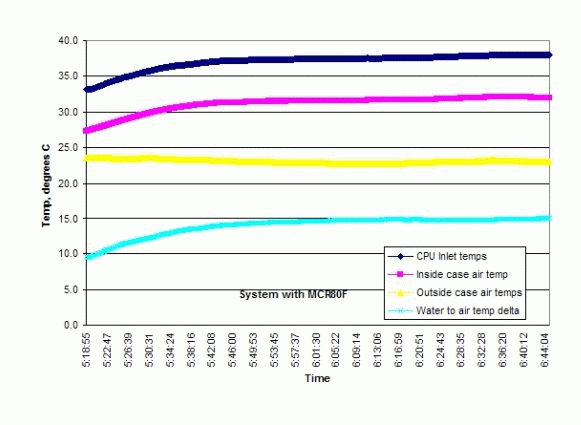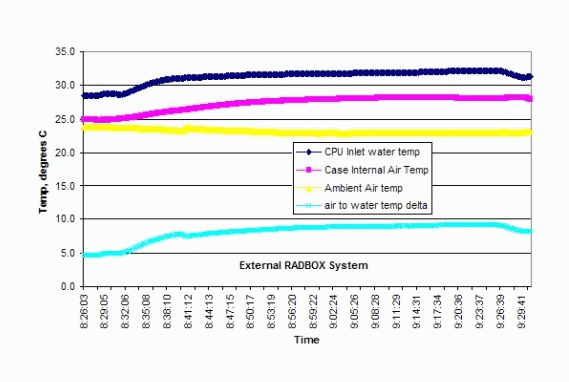|
|
|
|
 Swiftech MCB120 Radbox Kit Review Swiftech MCB120 Radbox Kit Review
|
|
Date Posted: Aug 13 2004
|
|
Author: Talcum
|
|
|
|
|
Posting Type: Review
|
|
Category: H2O and High End Cooling Reviews
|
|
Page: 1 of 1
|
|
Article Rank:No Rank Yet
Must Log In to Rank This Article
|
|
|
|
|
Note: This is a legacy article, imported from old code. Due to this some items on the page may not function as expected. Links, Colors, and some images may not be set correctly.
|
|
|
Swiftech MCB120 Radbox Kit Review By: Talcum
|
|
|
|
|
Swiftech MCB120 "Radbox" kit
Pro/Geeks! By: talcum (R. Legg) 8/13/04
|
|
|
This article was submitted via the Pro/Geeks! service ProCooling runs for its readers and cooling geeks like you. Monthly we offer prizes for those readers or just overall geeks that can write the best articles/reviews and want them posted on ProCooling. For more info on how you can get some free stuff, please check this link!
|
|
The Immediate Problem: My son had an SK7 and a Vantec Tornado which was turning my brain to tapioca.
The Immediate solution: Water cool and reduce the dB's.
What happened: I used the pump and waterblock from a "WS-5 Mission II Water cooling Kit" and a Swiftech MCR80F 80 mm radiator to improve the heat dissipation . The 80 mm radiator was the largest I could install in this skyhawk case without really butchering it. To complicate things even more the case only had a 60 mm rear case fan opening.
The problem then was that the temps for his overclocked Barton 2500 (200 FSB, stock multiplier, 1.65 Vcore) weren't very good and  that hi-intensity "Call of Duty" caused the machine to crash. To fix that would require case modification (a non-starter since it was my first Al case. An early Skyhawk – and it is so pretty), or replacing his video card with my OTES 9800 Pro. The 5900XT he gave me in return was good for AutoCAD. that hi-intensity "Call of Duty" caused the machine to crash. To fix that would require case modification (a non-starter since it was my first Al case. An early Skyhawk – and it is so pretty), or replacing his video card with my OTES 9800 Pro. The 5900XT he gave me in return was good for AutoCAD.
Enter the new, shiny, MCB-120™ "Radbox" radiator/fan housing, which should allow me to lower the overall system temperature and reclaim my 9800 pro.
|
|
Figure 1: What the system originally looked like. Note the old Skyhawk blower which could be positioned over the air cooled CPU.
|
|
REVIEW: How does the MCB-120 compare with the MCR80F on a small system?
The test equipment used was an HP 3497A with an option A, 5.5 digit DMM and current source. The device was cross calibrated against an HP34401 with certs for this test. The sensors used were an OMEGA 1PT100KN1515CLA type A RTD and two 580C49, 200 ohm RTDs. The type A RTD was glued using Arctic Alumina epoxy into a 1/8" hole in a brass 3/8" hose mender, Figure 2, and then stress relieved by potting the leads in blue permatex. The three sensors were wired in four wire configurations through an HP 44421A 20 channel with guard switch. The sensors were switched in a four wire configuration using the 1 mA internal source. The three RTDs were cross calibrated by immersion in an ice bath in a crock pot and slowly bringing the temp up to greater than 50 C while recording resistances using the 3497A. This test was repeated twice to give two sets of calibration data for fitting. I used the Callendar-van Dusen coefficients, http://www.prelectronics.dk/filer/CvD_UK.pdf , for Pt RTDs and fit the two 200 ohm reactor RTDs to the OMEGA type A sensor. The room was not temperature controlled beyond ordinary household central air-conditioning. 20 channel with guard switch. The sensors were switched in a four wire configuration using the 1 mA internal source. The three RTDs were cross calibrated by immersion in an ice bath in a crock pot and slowly bringing the temp up to greater than 50 C while recording resistances using the 3497A. This test was repeated twice to give two sets of calibration data for fitting. I used the Callendar-van Dusen coefficients, http://www.prelectronics.dk/filer/CvD_UK.pdf , for Pt RTDs and fit the two 200 ohm reactor RTDs to the OMEGA type A sensor. The room was not temperature controlled beyond ordinary household central air-conditioning. |
|
Figure 2: The type A RTD was glued using Arctic Alumina epoxy into a 1/8" hole in a brass 3/8" hose mender,
|
|
|
The algorithm used was, switch sensors, wait two seconds for the reading to settle and then take three readings and average them, then switch to the next
|
|
|
sensor and do it all again. A set of 10 precision resistors previously measured using the HP34401 DMM in the range of 100 to 270 ohms was used to test the system. The largest error observed was 7 microvolts out of the 0.199843 volt measurement.
The layout for the watercooling loop for the system is pump->WB->radiator->reservoir. The waterblock was not removed or disturbed between the sets of runs. The hose run from the pump to the waterblock was not changed, however about 2" were removed from each of the hoses which had connected to the old MCR80 radiator to facilitate connection to the new PCI slot hose pass-through included with the external Radbox kit. The system was filled (and refilled after hose reconnections) with distilled water and a 15% by volume Zerex solution (sorry Bill). The installation of the RTD in the CPU inlet can be seen in Figure 3, along with one of the 200 ohm RTDs placed to measure internal case temps. radiator to facilitate connection to the new PCI slot hose pass-through included with the external Radbox kit. The system was filled (and refilled after hose reconnections) with distilled water and a 15% by volume Zerex solution (sorry Bill). The installation of the RTD in the CPU inlet can be seen in Figure 3, along with one of the 200 ohm RTDs placed to measure internal case temps.
In the actual tests the sensor cables were routed with the pump power cord through a PCI card slot and the covers were replaced. The RTD used to measure internal case air temps rested between the top of the pump and below the videocard at an angle, see Figure 4. The third RTD was placed on the shelf at the front of the case to measure the ambient case inlet air temperature.
The pump used in the system appears to be about a 125 GPH at 0 head device, but no attempt was made to measure actual flow for this test.
|
|
|
|
Figure 3: The installation of the RTD in the CPU inlet
|
|
|
The Radbox combines a 120x25mm fan and radiator with an external mounting system and a PCI slot hose pass through. As with all things Swiftech, the build quality was excellent. I could have used an extra couple of ½" standoffs because of the staggered back of my case, but this is very minor. Extra assembly hardware was included. SFF users should also plan their mounting point to avoid interferences with the cables at the rear of the case. Installation time should be under 30 minutes if you wisely remove the box from under the desk(!).
|
|
Figure 4. MCR120 Kit installed. Note how much more open the box is, even with the extra RTDs.
|
|
The system was tested by running Sandra's "Burn in" module at normal priority with only the CPU arithmetic test selected. The CPU utilization was set to 100%. 3Dmark2001SE was then run in a continuous loop in the foreground to heat up the videocard.
The largest delta seen with the old system was 15 degrees C between the ambient air temp and the CPU inlet water temp at a water temp of 38.5 degrees C and a Sandra CPU temp of 43 C (bogus). The case temps were also very high, 32 to 33 C.
The case was then replumbed with the Radbox. The improvement was startling.

The Radbox lowered the CPU Inlet water temp and case internal air temps by 4 to 6 degrees at load. The delta in temperature between the ambient air temp and the CPU inlet water temperature was also lowered by 6 degrees C. "USDM", the EPOX monitoring tool also reported a drop in CPU temp of 6 degrees C between the two runs.
Note that the internal case and CPU inlet water temps have dropped by 5 degrees. This can more clearly be seen if the performance of the MCR80 is compared to the MCR120 and radbox:

|
|
This is a very well built kit, with high fit and finish quality. My results were very good, with the system improving overall temperatures substantially without adding noise or requiring a great deal of metal rework to the case. I used a somewhat anemic mystery pump, and your results might vary with more flow. It should work very well with a SFF case and a small pump. The system is more stable than with the MCR80 and, best of all, there is no Vantec Tornado next to my ears
|
|
|
|
| Random Forum Pic |
 |
| From Thread: Convection radiator design |
|
| | ProCooling Poll: |
| So why the hell not? |
|
I agree!
|
 67% 67%
|
|
What?
|
 17% 17%
|
|
Hell NO!
|
 0% 0%
|
|
Worst Poll Ever.
|
 17% 17%
|
Total Votes:18Please Login to Vote!
|
|






 Swiftech MCB120 Radbox Kit Review
Swiftech MCB120 Radbox Kit Review
 that hi-intensity "Call of Duty" caused the machine to crash. To fix that would require case modification (a non-starter since it was my first Al case. An early Skyhawk – and it is so pretty), or replacing his video card with my OTES 9800 Pro. The 5900XT he gave me in return was good for AutoCAD.
that hi-intensity "Call of Duty" caused the machine to crash. To fix that would require case modification (a non-starter since it was my first Al case. An early Skyhawk – and it is so pretty), or replacing his video card with my OTES 9800 Pro. The 5900XT he gave me in return was good for AutoCAD.
 20 channel with guard switch. The sensors were switched in a four wire configuration using the 1 mA internal source. The three RTDs were cross calibrated by immersion in an ice bath in a crock pot and slowly bringing the temp up to greater than 50 C while recording resistances using the 3497A. This test was repeated twice to give two sets of calibration data for fitting. I used the Callendar-van Dusen coefficients,
20 channel with guard switch. The sensors were switched in a four wire configuration using the 1 mA internal source. The three RTDs were cross calibrated by immersion in an ice bath in a crock pot and slowly bringing the temp up to greater than 50 C while recording resistances using the 3497A. This test was repeated twice to give two sets of calibration data for fitting. I used the Callendar-van Dusen coefficients,  radiator to facilitate connection to the new PCI slot hose pass-through included with the external Radbox kit. The system was filled (and refilled after hose reconnections) with distilled water and a 15% by volume Zerex solution (sorry Bill). The installation of the RTD in the CPU inlet can be seen in Figure 3, along with one of the 200 ohm RTDs placed to measure internal case temps.
radiator to facilitate connection to the new PCI slot hose pass-through included with the external Radbox kit. The system was filled (and refilled after hose reconnections) with distilled water and a 15% by volume Zerex solution (sorry Bill). The installation of the RTD in the CPU inlet can be seen in Figure 3, along with one of the 200 ohm RTDs placed to measure internal case temps.



